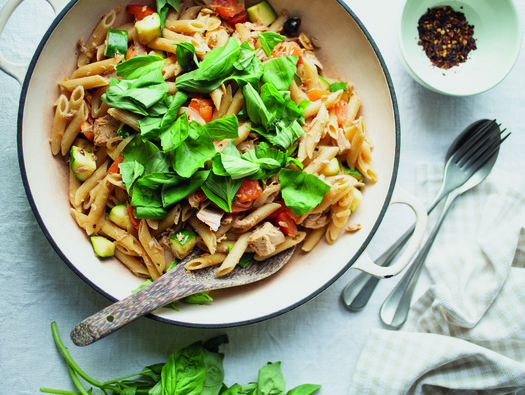Tuna, tomato and olive pasta

This pasta dish is low in phosphate and potassium but full of flavour. It can be ready in less than 30 minutes and is high in protein, making it ideal for those receiving dialysis.

This pasta dish is low in phosphate and potassium but full of flavour. It can be ready in less than 30 minutes and is high in protein, making it ideal for those receiving dialysis.
400g penne pasta, dried
1 tablespoon olive oil
2 garlic cloves, thinly sliced
400g fresh tomatoes, roughly chopped
50g pitted black olives, roughly chopped
1 onion, thinly sliced
1 courgette (approx. 150-180g), cubed
½ teaspoon chilli flakes
340g tinned tuna in spring water
Ground black pepper
10g basil leaves
Fill a large saucepan with water and bring to the boil. Once boiling, add the pasta and cook for 10-12 minutes, or as per instructions on the packet. Add the oil to a frying pan and place over a medium heat. Add the garlic, tomatoes, olives, onion and courgette cubes to make your sauce.
Stir in the chilli flakes and bring the sauce to the boil, then reduce the heat and simmer for five minutes.
Open and drain the tin of tuna. Break the tuna up with a fork and stir into the sauce. Simmer for two minutes. Season with black pepper. Gently tear the basil leaves and add them to the sauce.
When cooked, drain the pasta and carefully toss through the sauce. To serve, divide between four plates.
The pasta is the main source of carbohydrate in this dish and the value has been provided for those who have been trained in insulin adjustment.
Tomatoes are a high-potassium food, but when used in the quantities in this recipe, and as there are no other high potassium foods served with it, this is a low potassium dish overall.
This dish is low in phosphate but does still contain a small amount, so if you have been prescribed a phosphate binder, ensure you take them with this dish.
The tuna in this dish makes it a high protein meal, therefore it is suitable for those receiving dialysis or who have been advised to increase the amount of protein they eat. If you wish to reduce the protein in this dish, replace the tuna with a plant-based protein, such as a 400g (drained) tin of beans, lentils or pulses.
Use gluten-free pasta.
Using tuna canned in spring water and not brine keeps the salt content as low as possible. You may like to try wholemeal pasta to increase the amount of fibre in this dish.
You could replace the fresh tomatoes with a 400g tin of tomatoes. If you prefer to use dried basil instead of fresh, add a teaspoon of dried basil at step 3.
Allow to cool, then store in the fridge in an airtight container for up to three days. Can be re-heated or eaten cold.
To get the best flavour, tear your basil leaves instead of cutting them.
By giving us your email address, you're giving us permission to send you the latest news from Kidney Care UK. Further information about how we protect and use your personal data is available in our Privacy policy. If you would like to change the way we communicate with you at any time please email [email protected]. You can unsubscribe at any time by using the link at the bottom of every email we send.